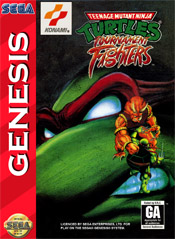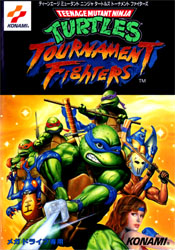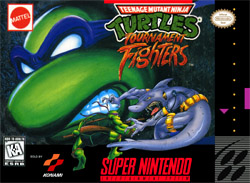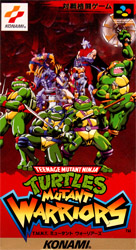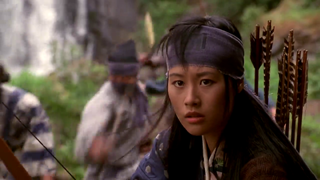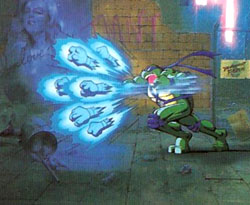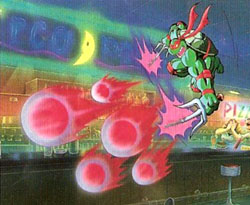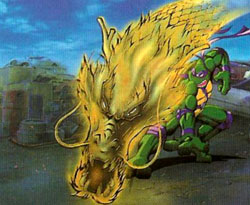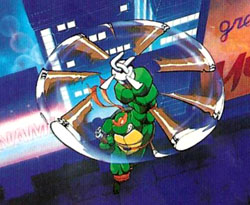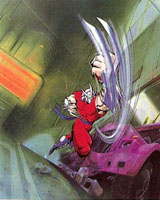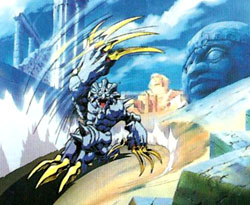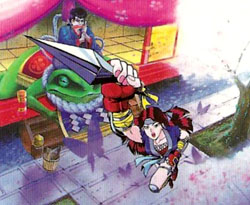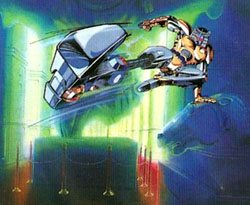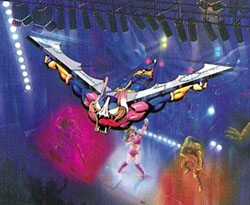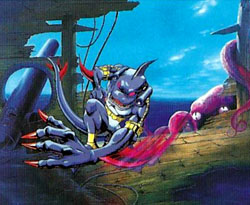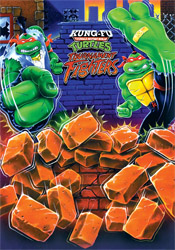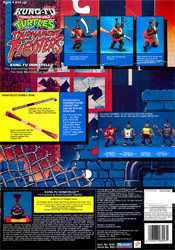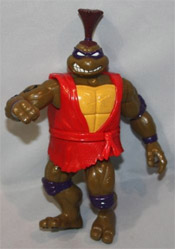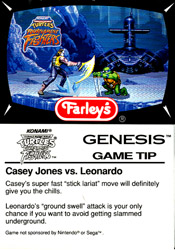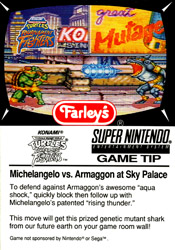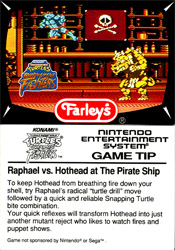
|
Page 1: |
Page 2: |
Page 3: |
Page 4: |
Page 5: |
|
Page 6: |
Page 7: |
Page 8: |
Page 9: |
Page 10: |
|
Page 11: |
Page 12: |
Page 13: |
Page 14: |
|
Genesis Version
Starting in the end of 1992, the TMNT franchise was beginning to suffer from overexposure and public fatigue, with excessive marketing on the many different toy series coming out, several comic books on the shelves from the original to the Adventures series, television cartoon and the new third live action movie in theatres. A major issue that had grown out of the many branches was the fact that the fanbase had become increasingly divided, especially between Archie's Adventures comic book and the cartoon, and the very vocal yet smaller fanbase growing disgruntled with the Mirage comics as well. In attempt to centralize the fanbase more and keep the TMNT name from waning, the biggest marketing campaign since 1988 was about to take place throughout 1993, the aforementioned live action movie, 3 new toylines, and 3 new video games. The video games were to be released on the three major platforms - NES, SNES and the Sega Genesis - within a short span of time from one another. Teenage Mutant Ninja Turtles: Tournament Fighters was first released on the Sega Genesis in September of 1993. It was the only game from the Konami TMNT games to ever get a toyline made by Playmates. Farley's Fruit Snack also included "game tips" for each of the different versions produced in their TMNT Fruit Snacks packagings. The toyline did not feature any similarites to the design of the games nor characters available in either of the versions with the exception of the Ninja Turtles themselves.
Directed by Mitsuyo Taira who later would become a programmer on Britney's Dance Beat, the Genesis version focuses more on a darker and more subdued game with the American market in mind. It features several innovations for its time, most noteworthy being the ability to expand the levels by destroying scenery and an instant replay feature. Making use of three buttons, the strength of either punches or kicks is determined by holding a direction on the D-pad and pushing either which button, while the third button acts as a taunt. Taunt can be used when health is dangerously low to execute a Desperation move which can quickly turn the tides.
Splinter is again kidnapped by the Foot, though this time not by the Foot Soldiers, but rather evil clones of themselves taking Splinter back to Dimension X with them. Realizing they are now up against a much greater force than ever before, they enlist their friends to go with them to the evil Dimension and fight the clones and rescue their Master and father. The available roster in this game consists of Leo, Raph, Mike, Don, Casey Jones, April O'Neil, Ray Fillet and the Genesis exclusive original character; Sisyphus. The unplayable bosses are Triceraton, Krang and Karai. Shredder, now presumably defeated after the events of the previous game, is not featured in the game, so newcomer Sisyphus will have to do. Though the boss characters are rendered unplayable, there exists codes to make them playable through the use of cheat devices.
Each character has four special movies and a single desperation move, done by doing recognizable sequences of motion found in other fighting games at the time, such as Street Fighter II. Blocking is done by eholding in the opposite direction of the opponent, and the desperation moves are final resort moves that can only be done by taunting and a specific sequence of motion when the lifebar is flashing red, though if it connects properly will effectively take out most if not all of the opponents lifebar. Most moves and characters are balanced out well, with an answer to mostly every move in the game. Strength, speed and reach is determined by the standard affair of fighting game logic with larger characters being more grapple based brawlers and the Ninja Turtles being all rounders.
Beyond the surface of recognizable controls and fairly well balanced mechanics lies a myriad of flaws that brings the Genesis version of Tournament Fighters down quite far, most having to do with the difficulty in single player mode. Casey Jones, making his playable debut in this game, is virtually impossible due to his reach and speed, bundled with the fact that the computer AI is incredibly cheap, allowing for little in the way of offence on the player's behalf before being massacred into a puddle of turtle soup. This difficulty only ramps up as you progress, making the last few fights surely some of the most infuriating moments in video game history. It seems the larger stages and replay feature comes at the expense of a lot of both subtle and obvious details. Stages are for the most part shades of gray, visually uninteresting and completely static with little in the way of life or depth. Worse yet, the stage designers decided to put this guy in the background:
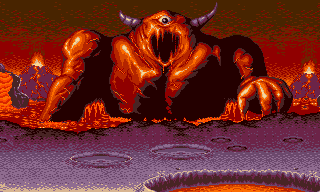
Christ, stop staring at me! Go back into the sewers with your mutant parents, I can't concentrate!
Anyway, things like this poop monster make the game look rather bland when it comes to the backgrounds. But at least it can't get worse than a one eyed monster staring you right between the eyes like it's ready to explode, right?
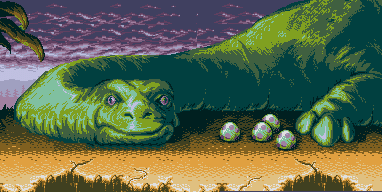
Denver the Dinosaur here would beg to differ.
The sprite characters are definitely gorgeous at first glance and the general design of each character is well done, but lack a good amount of animation frames, leading to some moves even being one single frame rather than a smooth flowing animation. April seems to be the character suffering most from this problem, and her sprite shows signs of being hastily modified from a certain female character in the SNES version in some of the moves, suggesting that the SNES game was the lead production out of the three games.
Apart from the single player mode that tells the story of the game between matches, there is also the Tournament mode, exclusive to the Genesis version. Tournament mode is one of the first example of a Survival mode found in many fighting games today, where the goal is to survive a total of 88 matches on a single lifebar. It might seem like the idea is good when one thinks to Survival modes today in games such as Dead or Alive, but in Tournament Fighters, it feels more like a hastily made mistake as it is impossible to even fathom anyone surviving 88 matches when the game already is a beast in terms of difficulty. One might also think that there must be a grand prize for surviving so many matches and that there must be a reason for it to be in the game, but rest assured, with the help of save states and over-the-counter sedatives, we can dazedly announce that there is nothing to be gained from beating all 88 matches.
The second TMNT game to land on a Sega console struggles to find stable footing when not having the benefit of previous titles to support it self with. The characters and general character design is strong and the soundtrack is for the most part great, as can be expected when a game is scored by Suikoden's Miki Yanagisawa, even though the sounds are a little bit flat and the voice clips are near unintelligible. But for all the interesting ideas and choices Tournament Fighters presents, the ideas are all novelties in conception rather than useful in execution. The fundamentals of the game are too broken for any novelty to save it from being largely mediocre.
Chris Allan was brought in to do all the Tournament Fighters artworks for the Western releases, and each cover has a different Ninja Turtle fighting an enemy, which actually are featured in the game this time around. For the Genesis version, Raphael is fighting Triceraton. The Japanese version features artwork based on the live action design of the TMNT, done by an unknown artist not associated with Mirage. The stage selection screen also bears very strong resemblance to another Konami game based on a Western property, Bucky O' Hare.
Quick Info:
|
Developer: |
|
|
Publisher: |
|
|
Director: |
|
|
Genre: |
|
|
Themes: |
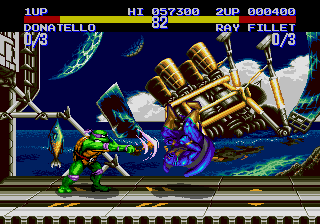
Teenage Mutant Ninja Turtles: Tournament Fighters (Genesis)
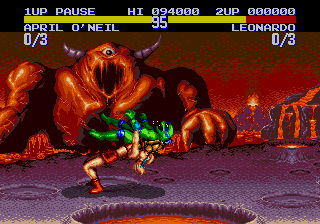
Teenage Mutant Ninja Turtles: Tournament Fighters (Genesis)
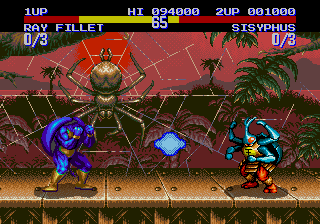
Teenage Mutant Ninja Turtles: Tournament Fighters (Genesis)
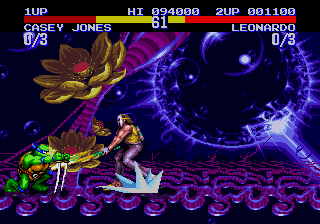
Teenage Mutant Ninja Turtles: Tournament Fighters (Genesis)
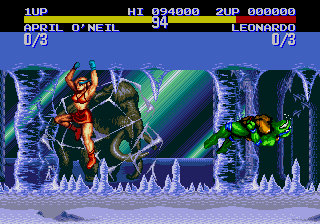
Teenage Mutant Ninja Turtles: Tournament Fighters (Genesis)
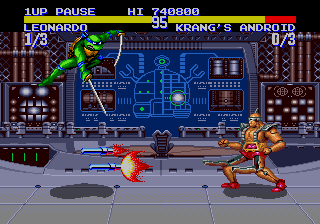
Teenage Mutant Ninja Turtles: Tournament Fighters (Genesis)
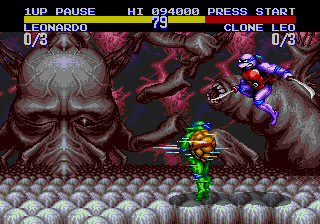
Teenage Mutant Ninja Turtles: Tournament Fighters (Genesis)
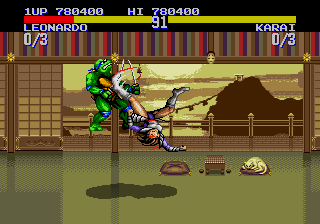
Teenage Mutant Ninja Turtles: Tournament Fighters (Genesis)
Released in late November, two months after the Sega Genesis game, the SNES version of Tournament Fighters is a completely different game and headed by many of the development mainstays of the TMNT series. The directorial reigns were given to Takemasa Miyoshi for this game. Miyoshi had been an employee at Konami for some time by the time of this game's release as a scenario writer and designer, having contributed to Konami's ever expanding arcade technology and also been part of Hyperstone Heist's designer team. For this game, Miyoshi was not only the Director, but also the character designer, planner and lead programmer. Under his watch, several characters would be re-imagined quite radically.
The story of SNES's Tournament Fighters depends on the mode selected between either Arcade Mode or Story Mode. The Arcade Mode is a quest for each fighter to enter a tournament to win a hefty cash prize, which they all want to use for different purposes, some evil, some selfish, some giving. The Story Mode is in some ways a liberal retelling of the very first TMNT game on NES, with Splinter and April having been kidnapped by the Foot, challenging them to come rescue their friends before it is too late, and the brothers setting out in their blimp throughout the city for clues. While the kidnapping of April and Splinter has been the general premise for many games, there are several hints throughout that the idea of making use of elements from the first game's story and setting was done consciously. Apart from these modes, there is also a two player option and a Watch mode for CPU fights. The roster is now more of an all star line-up from all corners of TMNT, with the four shellshocked brothers naturally in the forefront, but also several characters from the Adventures comic book series, such as Wingnut, Armaggon, and WAR, while Chrome Dome from the cartoon makes his jump over to a TMNT video game. Shredder appears as a playable character for the very first time ever, and his design is similar to that found in Hyperstone Heist, though no longer donning his cape. His Cyber Shredder name is retained from Radical Rescue. Rat King and Karai acts as the game's bosses. There is also one original character in the game, Aska. Unlike the Genesis games, the bosses can be selected with a cheat code found in the game.
While the Genesis version was a three (well, two really) button figher, the SNES game is now a four button fighter with Y and B acting as light strikes while X and A are fierce strong strikes. Each character has fewer special moves compared to the Genesis game, though the emphasis is on speed and combos rather than special moves in the SNES version. Taking several pages out of Street Fighter II Turbo and Fatal Fury 2's book, Tournament Fighters on the SNES is filled with lightning speed combos and counters and great care is taken to balance the characters even more so than in the Genesis game, and on par with the console releases of Street Fighter II. Even the Ninja Turtles themselves now feel completely different from one another, not just in speed or strength, but in the way their moves and controls are set up which is based around the fluidity of their weapons. The supporting cast also show great care taken to their movesets and designs, creating a roster worthy of a good fighting game. Again showing some innovation, the game features a Mutant Meter, which is basically a SNK style special meter which can be used to unleash devastating finishing moves when filled up by pressing both X and A together. After the release of Tournament Fighters, the idea of special bars and knockout specials became common place in fighting games. Even though the game in a normal setting is quite fast, the options menu allows to ramp up the speed significantly, making for some of the most intense matches on a console fighter. With the Konami code, the game allows even for more speed, becoming virtually unplayable on the fastest setting for regular players.
As mentioned, many of the characters have been redesigned for this game specifically. The Turtles themselves look much more sinister and detailed, closer to Dooney's interpretations of the brothers, while retaining the separate colored headbands. Rat King is probably the most drastically redesigned character in the whole game, being transformed from a twisted lean psychopath to a brawling muscular wrestler, utilizing grapple moves and showing a much more visually intimidating representation. Though radical, through great design the changes made to the characters works in favor of the game, being recognizable for fans, and useful for the game's layout. The new portraits and illustrations shown throughout the manual and game cutscenes provides a whole new unique artistic take on the franchise, though sadly despite its quality it would not see more use further down the road.
When speaking characters in Tournament Fighters, most of the attention is given to the original character Aska, a beautiful and deadly female ninja exclusive to this game. Since the very first public reveal of the game in 1993 in game publications, her origins have been speculated on, and many theories have come to light from this. The most obvious theory most often reported was that it was originally set to be April instead of Aska, but for whatever reason it was changed. Others speculated that Konami was not convinced the TMNT name was strong enough among the Japanese gaming community, so they designed an original character with more Japanese styled origins. While it's hard to say if April was ever planned to be part of the lineup at some point or another during the planning stages, the TMNT name was quite strong in Japan, especially in the video game market due to the quality of the arcade games and the NES games being highly popular. However the truth on Aska's origins can be found inside the game code itself on a beta release.
On the beta release, with the assist of some modified code, Aska is selectable in an unfinished form under a very different name; Mitsu.
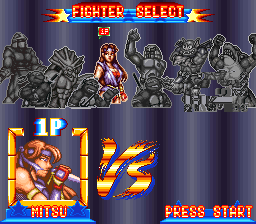
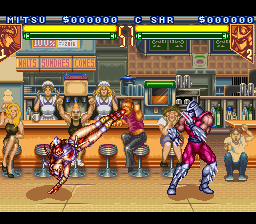
At some point, Aska was slated to be the female character and love interest of Michelangelo in the third live action movie which was released earlier in 1993. However, the movie underperformed and was critically and publicly reviled, leading to the character to be scrapped due to it being completely forgettable. Her appearance remains largely the same between the name changes, meaning Mitsu would probably have been a very similar character just given a design change much like Rat King. Aska also features many changes made on her sprite and appearance between the US release and the Japanese release, adding to the interest in the character. Another interesting character is the clone that appears throughout the story mode. Though at first it might seem like a carry over idea from the Genesis game, there is a bit more to the clone in this game, being that the battle against him is actually a throwback to the first TMNT game, where a similar battle took place.
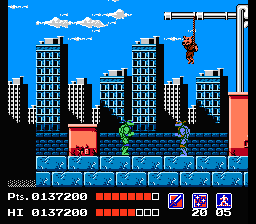
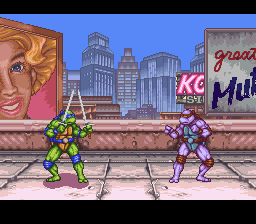
Graphically and musically, the game is top rank, among the very best on SNES. Unlike the Genesis game, the SNES stages flows with life and color, with the scenic background of the rooftop overlooking New York City to Channel 6 television studio, each stage has tons of character and charm. Each character has great size and a wealth of animation frames, giving everyone a distinct look and feel against one another. The cutscenes are also filled with a great amount of detail, and have a more Japanese animation look to it ever before, with April O'Neil benefiting greatly from this in her supporting role. Kazuhiko Uehara acted as the composer on the game, and is among the strongest of all the TMNT games released when it comes to music quality with high tempo game rock and fusion pop music.
By the time Tournament Fighters on SNES saw release, the ship had already sailed for the franchise to regain its momentum, and TMNT suffered greatly in the holiday season of 1993, still suffering from the poor reception of the movie. As a console fighter, Tournament Fighters is arguably one of the very best available on a 16-bit console and in some aspects better than the Street Fighter II ports. In comparison to the arcade editions of Street Fighter II, there's not much of an argument of Capcom coming out on top constantly redefining the genre, but in terms of the ports they made available, while great in their own right, suffered from loss in animation, sprite size and speed. Tournament Fighters is tailor made for the SNES and managed to bring all the excitement and depth of an arcade fighter to a home console and even add some unique features of its own along the way, without any gimped graphics or sound. It was just simply too late to the party, and as such overlooked despite its excellent quality. There was some early criticism over the roster being filled with largely unknown characters, though over time as fans began to surround themselves more with the TMNT universes, opinions shifted to a more positive tone.
Of all the TMNT games, the SNES Tournament Fighters holds the most differences between regional releases. Released in Japan as Mutant Warriors, the Japanese version holds several improvements. As noted, Aska is now slightly modified to appear slightly more luscious with skimpier attire and bouncing breasts in her all new winning animation, bringing her overall appearance and behavior closer to that of SNK's Mai Shiranui. Some moves across each character is slightly modified in hit percentage and reach to further balance the game. All new voice clips, some taken from Turtles in Time, were implemented for more clear recognition of the moves, and Studio 6 now featured breakable walls to allow for stage extension as seen in the Genesis game.
Allan's cover art has Donatello fighting Armaggon, while the Japanese release uses Miyoshi's illustrations as cover art.
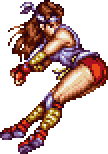
Hip Launch (Tournament Fighters)
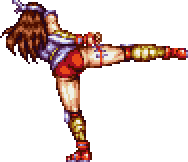
Strong Kick (Tournament Fighters)

Victory Animation (Tournament Fighters)
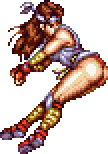
Hip Launch (Mutant Warriors)
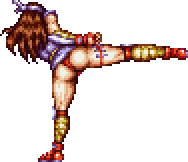
Strong Kick (Mutant Warriors)
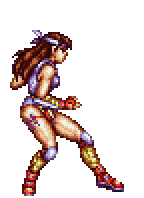
Victory Animation (Mutant Warriors)

Teenage Mutant Ninja Turtles: Tournament Fighters (SNES)

Teenage Mutant Ninja Turtles: Tournament Fighters (SNES)
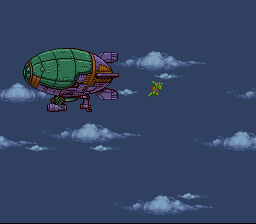
Teenage Mutant Ninja Turtles: Tournament Fighters (SNES)
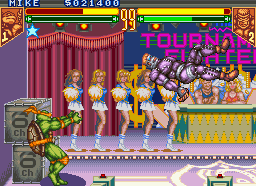
Teenage Mutant Ninja Turtles: Tournament Fighters (SNES)
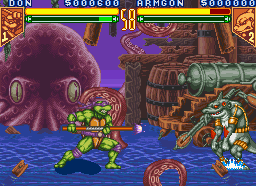
Teenage Mutant Ninja Turtles: Tournament Fighters (SNES)
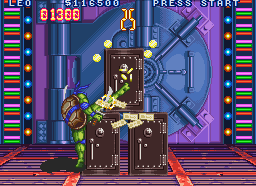
Teenage Mutant Ninja Turtles: Tournament Fighters (SNES)

Teenage Mutant Ninja Turtles: Tournament Fighters (SNES)
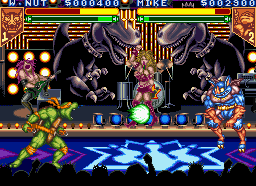
Teenage Mutant Ninja Turtles: Tournament Fighters (SNES)
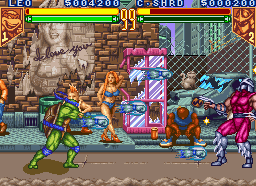
Teenage Mutant Ninja Turtles: Tournament Fighters (SNES)
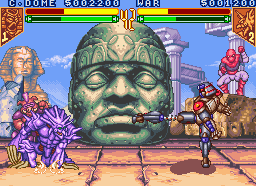
Teenage Mutant Ninja Turtles: Tournament Fighters (SNES)
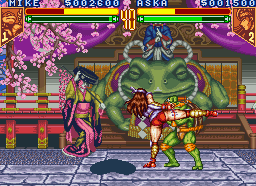
Teenage Mutant Ninja Turtles: Tournament Fighters (SNES)
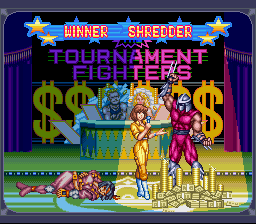
Teenage Mutant Ninja Turtles: Tournament Fighters (SNES)
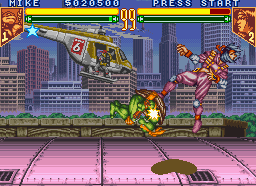
Teenage Mutant Ninja Turtles: Tournament Fighters (SNES)
Japanese Ratking Stage
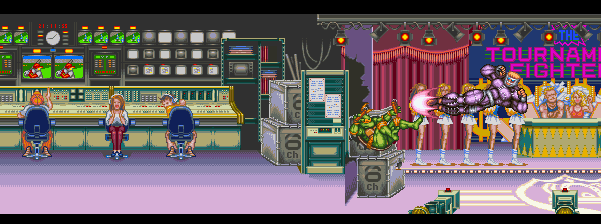
Panoramic Stage View
Ending Sequences
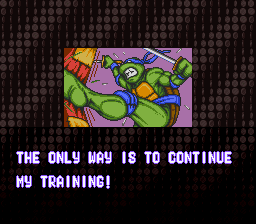
Leonard
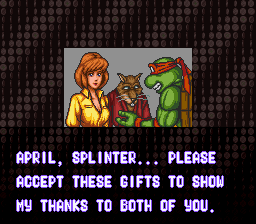
Raphael
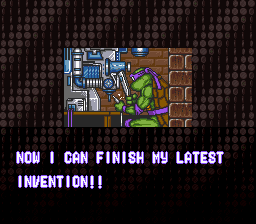
Donatello
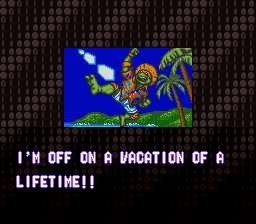
Michaelangelo
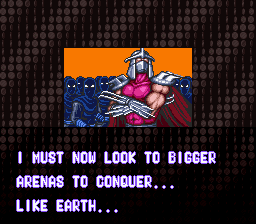
Cyber Shredder
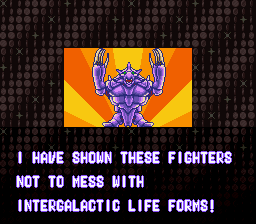
WAR
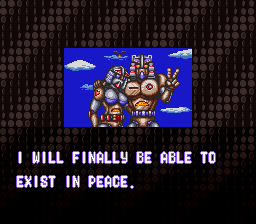
Chrome Dome
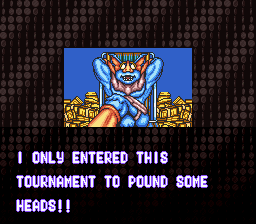
Wingnut

Armaggon
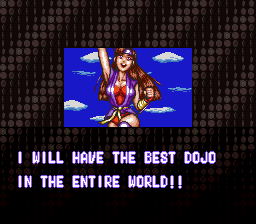
Aska
Takemasa Miyoshi Illustrations
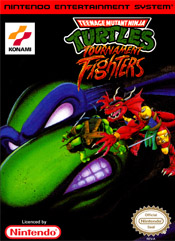
US Cover
The ninth last officially released game on the NES, Tournament Fighters took to the 8-bit arena for one last showdown with the characters that had helped solidify its place in pop culture and on the sales chart. Strangely, Tournament Fighters was released on the European market, but not in the Japanese market, even after Manhattan Project was not released in Europe at all.
Dealing with a much weaker technology, the game is significantly smaller than its 16-bit counterparts, though it's not in all ways inferior. The storyline in this game differs from all the other games, and is perhaps a bit illogical in the way it is presented. Shredder is again the main antagonist, and Splinter has once again been abducted, though the turtles decide to fight amongst themselves to prove their worth to finally challenge Shredder to a final showdown. Along with the four green machines, Casey Jones and Hothead also join the battle.
There are four modes of play in the game, Story, Vs CPU, Vs Player and Tournament. The Story mode is the official storyline played out through a series of matches, finally culminating with the showdown with Shredder to free Master Splinter from his clutches. During this mode, only the four turtles are available for play. There is also a bonus stage in the midst of the Story mode. Vs CPU and VS Player are the standard versus modes where any character is up for grabs in standard exhibition matches, where also stages and handicaps can be set. Tournament is a 1-4 player mode where players can sign up and go for the price in a series of 1-on-1's to determine the best.
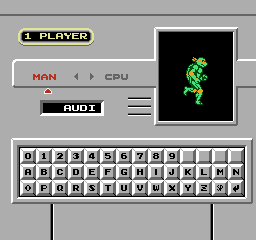
Tournament mode sign up screen
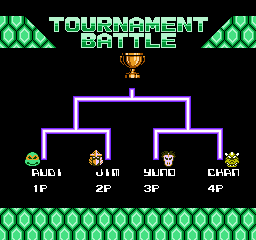
Tournament tree
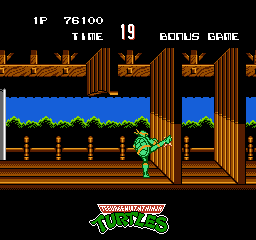
Bonus Stage
With only two buttons, the controls are more comparable to the Genesis game, and each character has an assortment of special moves, mostly single projectile based move along with two dash moves to counter quickly. However the special moves in this game are not particularly strong in comparison to other fighting games, and the reason is because of an item which is dropped randomly on each stage named the Ultra Ball. Any character is free to pick it up, and doing so allows for whoever is in possession of it to perfrom an ultra attack which is basically a glorified fireball which knocks a good percentage off the recipients' health bar. Once the ultra attack has been executed or if the holder is knocked to his feet, the ball bounces back onto the stage, so it adds another level of intensity with both players racing to pick up it up. Despite being an NES title, each of the moves are animated fairly well and look good, even if there is not many of them.
Even with just a few moves each, the controls are reasonably well done for an NES fighter and they respond well to the commands. The graphics as well are very well done, with Hothead's large sprite being fairly impressive by NES standards, and indeed, his size makes him unable to be chosen for a mirror match in the two player mode despite the other characters being able to do so. The challenge is pretty even throughout the game as well, increasing per stage at a comfortable pace. The soundtrack is largely uneventful and quite a disappointment for a TMNT game considering its musical legacy, though there is some interesting sides to the sound aspect of the game. The composer of the game, Syun Nishigaki, would go on from this game to compose the Akuma theme for Super Street Fighter II Turbo and become a prolific composer in his own right over at Capcom working on the Resident Evil and Street Fighter Alpha series, making him the only direct connection between Capcom and Konami in the Tournament Fighters series.
Due to technical limitations and demand, Tournament Fighters NES is an extremely short and rather uninspired game. It's not bad, playing well above what the Genesis game does, and for an NES fighting game it's a good effort, but it doesn't offer much to make it stand out among the other games. Due to its late release, it has become perceived as a rare game and collectible for NES owners. The cover features Leonardo fighting Hothead.
The NES version of Tournament Fighters is the first video game to depict the TMNT without their signature weapons, as they are nowhere to be found and the game focusing solely on hand to hand combat.
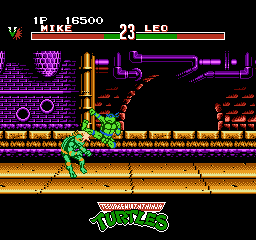
Teenage Mutant Ninja Turtles: Tournament Fighters (NES)
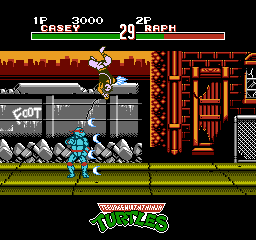
Teenage Mutant Ninja Turtles: Tournament Fighters (NES)
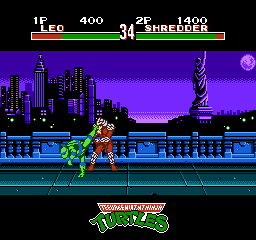
Teenage Mutant Ninja Turtles: Tournament Fighters (NES)
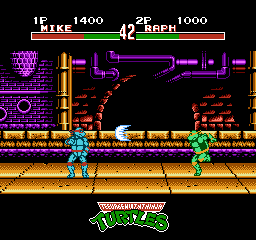
Teenage Mutant Ninja Turtles: Tournament Fighters (NES)

Teenage Mutant Ninja Turtles: Tournament Fighters (NES)
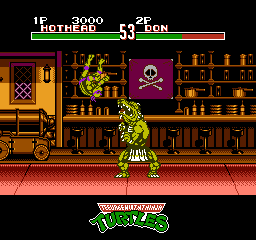
Teenage Mutant Ninja Turtles: Tournament Fighters (NES)

Teenage Mutant Ninja Turtles: Tournament Fighters (NES)
TMNT Tournament Fighters Toyline
Farley Fruit Snacks Tips
|
Page 1: |
Page 2: |
Page 3: |
Page 4: |
Page 5: |
|
Page 6: |
Page 7: |
Page 8: |
Page 9: |
Page 10: |
|
Page 11: |
Page 12: |
Page 13: |
Page 14: |
|
